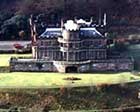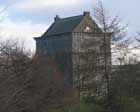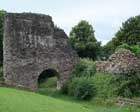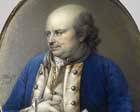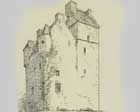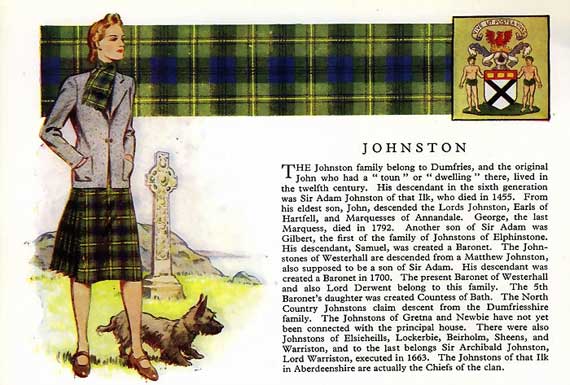 |
||
 |
||
Johnstone ClanNunquam non paratus |
||||||
|
Clan Johnstone information
|
||||||
 |
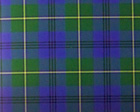 |
 |
||||
|
Clan crest badge |
Clan Seat |
Johnstone tartan |
Clan Location |
|||
|
Lochhouse Tower |
Lochmaben Castle |
George Johnstone |
Elsieshields Tower |
|||
Clan HistoryThe Johnstone clan kept watch on the western border with England for six hundred years. The name is first recorded in that area in 1194 when there is mention of a John Johnstone who had a son called Gilbert. So John Johnstone must have been a son of John from an even earlier period. Cadet branches started to take shape in the families increasing territories with John, Adam's eldest starting the Annandale branch and his brother Mathew starting a line at Westerhall. The Clan kept most of their aggression for the English but there was a couple of ongoing feuds with the Maxwells and the Moffats. The feud with Clan Moffat came to a head when the Johnstones killed Robert Moffat, clan chief, in 1557. They also burnt the local church with the Moffat hierarchy all inside cutting down any that tried to escape. The Moffat clan never recovered and seventy years later the Johnstones took control of their lands when they could not meet accrued debts. James Johnstone, clan chief in 1633, was created Lord Johnstone of Lochwood by King Charles 1st. Ten years later he was given the title of Earl of Hartfell. He joined up with Montrose to defend the Royalist cause in 1645. Captured with his eldest son at Philiphaugh, their lives were spared at the behest of Argyll himself but they were to be imprisoned. William the 3rd Earl was promoted to Marquess of Annandale in 1701 as reward for services, being Secretary of State and President of the Privy council. During the next, nearly, 200 years there were attempts to re-instate the titles but it was not until 1971 that it looked possible. In 1982 the Lord Lyon recognised Major Percy Johnstone of Annandale and of that Ilk as an heir to the dormant titles. The case was brought to the House of Lords in 1985 and the court found in favour of the Major's son Patrick, Earl of Annandale and Hartfell and Chief of the Clan. Another senior branch of the clan is the House of Caskieben. Sir George Johnstone of Caskiebenwas created a Baronet of Nova Scotia in 1626. The 3rd Baronet fought in the army of King William of Orange in 1690 at the Battle of the Boyne. The 11th Baronet lives in America. The Clan have their fair share of local members who have stood up to play on the world stage. These two George's would be a typical example in that period. George Bain Johnstone from Annan who rose to the ranks of Lieutenant Colonel in 1808. Among his achievements were the key role he had in the only successful armed takeover of Government in Australia's recorded history, known as the Rum Rebellion. For which he was returned to Britain and cashiered, he left as a civilian to return to New South Wales and lived out his life with his family on his estate named Annandale, he died much respected in January 1823, leaving a large family. Clan Castles Lochwood Castle or Tower is a ruin to the south of the town Moffat. There has been a fortification on this spot long before the name Johnstone appeared in the area and it is not known exactly when or how they took possession. The stone castle remains that are seen today date back to the mid 15th century. It is believed that John Johnstone of Johnstone, Clan Chief from 1454 until 1493 may have built it. In it's history it was captured and held by the English when a paid servant girl let them in at dawn. It was also burnt out at least three times and refitted. It was the clan seat for the Earl of Annandale until the early 1700's. Lochhouse Tower is situated within a mile of Beattock Station. It is a fair example of the Border pele. It stands on the brow of a slight hillock, two sides of which were formerly washed by a loch, which has now been drained. The tower is 38 feet by 28 feet, with walls 6 feet in thickness and rounded on the angles. No details of when it was built but probably in the 16th century. It belonged to the Johnstones of Corehead. It was allowed to lapse into decay however in 1986 it was refurbished and is today a modernised dwelling. Elsieshields Tower stands on the banks of the Ae Water, about two miles north of Lochmaben. It was a simple keep, with a square tower built at one of the angles to contain the staircase. The entrance door was on the ground floor, and is commanded by a shot-hole from the kitchen, which occupied the whole of that floor. The first floor contained the hall, with bedrooms on the two upper flats. The top story is provided with dormer windows and large angle turrets, used as dressing-closets. There is a watch-turret erected on the west gable of the staircase tower. It is corbelled out and balanced on the gable top with just room inside for a watchman to stand and look about him. There would have been a large beacon grating for a signal fire. It belonged to William Johnstone of Elshieshields and in 1602 was burnt by Maxwell of Kirkhouse. Lochmaben Castle by Lochmaben in Dumfriesshire, was a hereditary castle of the Bruces, it was at one time the most powerful fortress on the Borders. The Lordship of Annandale was bestowed on the Bruces by David 1st in 1124, and it is said that their original castle was on the Castle-hill, close to the town, and the present castle (ruin) was originally built in the thirteenth century by Robert Bruce (King Robert's grandfather), the competitor for the crown, who died there in 1295. Westerhall in Dumfries is home to the Johnstone Baronetcy. It was originally a Douglas tower called Dalduran, seized by the Crown and given to the care of the Glendennings it was purchased in 1605 by James Johnston of Westraw. The name James Johnston of Westerhall first appears on record in 1606. Keith Hall, Caskieben Castle is located at Inverurie 17 miles from Aberdeen. The ancient castle was owned by the Johnstones until 1633. It is joined onto Keith Hall which is a large restoration mansion built by the 1st Earl of Kintore, Sir John Keith, who had purchased the properties in 1662. The surrounding gardens were originally landscaped by Capability Brown. It is the home of the current Earl and not open to the public. Raehills House was originally a hunting lodge for Hopetoun House. It stands on the Kinnel Water, 10 miles to the north of Lockerbie and was bought by the Johnstones in 1780. Tastefully expanded and remodeled in 1834. It is a luxury mansion house serving both as main dwelling of the Clan chief and also as a luxury hotel.
|
||||||
